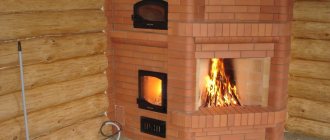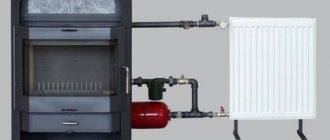From wooden boxes to smart technology
Such a simple and familiar object as a trash can came into use relatively recently: wooden boxes with lids appeared in Paris at the end of the 19th century, and in Moscow even later - less than a hundred years ago. In such a short period of time, waste containers have been transformed and are now presented in a variety of modifications: from ordinary open buckets to sensory containers and new generation devices that can compress, freeze or even recycle waste. And if it is not difficult to decide on the first option, choosing an innovative model requires a more careful approach.
What is a dousing device?
Fans of a real bathhouse know how pleasant it is to plunge into cool water after a steam room. Some people prefer to cool off in an ice hole or snow in winter. The cooling process not only gives vigor and well-being, but also has a beneficial effect on the human body: blood circulation improves, the skin becomes more elastic, and toxins and other toxic contaminants are removed from the body. The body rejuvenates and health improves.
Experts do not recommend dousing yourself with ice water if you were not familiar with this procedure before. Tips on how to properly start dousing after a bath:
- Douse yourself with lukewarm water the first few times. Avoid shocking contrasting temperature changes if you have not practiced dousing before;
- Gradually reduce the degree of water for dousing so that the body has time to get used to it.
It’s good if there is a lake or reservoir not far from the bathhouse. If there is no place to cool down after the steam room, a dousing container is used. To save money, many bath attendants make it themselves. What does a bath bucket look like? As a rule, a high-quality dousing container is made of natural wood. The container is secured using a movable mechanism in the bath room for washing. After visiting the steam room, a person stands next to the container, pulls a cord or rope, and a certain amount of cool water is dumped on top of him.
A dousing container is also called a “turnover” or a “waterfall bucket.”
How to choose a trash can
In order for a bucket to successfully cope with its main function - storing garbage, when choosing it you will have to take into account many parameters. Let's start with the most obvious - volume, shape, material.
Volume
The first step is to choose the size of the bucket: if it is too small, it will quickly overflow; if it is too large, waste will accumulate for a long time and smell unpleasant. The required volume of a trash can is determined based on the size of the family. A 5-liter container is enough for one person; three people will need a trash can with a volume of 15 liters or more.
Location
Most often, a garbage container is placed under the sink, but this is not the only option: the container can be installed in a kitchen cabinet, hung on a cabinet door, or built under a countertop. The trash can can also be placed outside, and in order not to attract unnecessary attention to it, in this case it is better to choose discreet colors that are close to the tones of the kitchen furniture. But you don’t have to hide stylish designer models – they will fit well into any interior.
Form
The shape of the trash can will largely depend on its location. It is easiest to place a rectangular or triangular trash can in a cabinet, niche or against a wall; a round bin will require a little more space. But it is better to avoid overly complex configurations with internal protrusions: dirt and germs will accumulate in the corners, and it is more difficult to wash such containers.
Material
Modern garbage cans are made mainly of two materials: plastic or stainless steel. The advantage of plastic buckets is their lightness and availability: their prices start from 200 rubles. Steel ones are about twice as heavy and cost more - from 1,500 rubles, but they are stronger and more durable.
Choosing a location
For comfortable use, you should correctly determine the installation location of the waterfall bucket. Typically, a sprinkler device is installed in the shower room, since this room is already equipped with a water drain. In some cases, a bucket-waterfall is installed on the street near the entrance to the bathhouse.
It is extremely important to correctly determine the installation height. In most cases, it is 1.8-2.2 meters, which guarantees convenient overturning of the device and optimal speed of water movement. If children want to use the device, it is enough to increase the length of the chain or rope used.
Types of trash cans
Having decided on the dimensions and material, we move on to the main thing - choosing a suitable container design. Depending on the design features, trash cans are divided into many types:
- open,
- with lid,
- with pedal,
- with abs,
- built-in,
- sensory,
- sorting systems.
Open buckets
Pros. Lightweight and accessible: such containers weigh from
300 g, their prices range from 100 to 1500 rubles. There are original solutions: for example, the Japanese Tubelor bucket consists of two parts. A garbage bag is inserted into the lower bucket of smaller diameter, and a decorative part made of bright plastic is put on top.
Minuses. Due to the lack of a lid, it is only suitable for dry waste: paper, cardboard, plastic, husks or shells.
Buckets with lid
Buckets with lids and valves are available in the assortment of the German company Wesco, the Dutch company Brabantia, Koziol, the cost is from 3,500 to 22,000 rubles.
Pros. The buckets are easy to use and versatile: the lid blocks odors.
Minuses. The lid can be removable, moves on hinges or is fixed open. But in any case, you have to take it, hold it or cover it with your hand.
Buckets with pedal
Reliable and stylish pedal tanks are supplied to the market by Wesco and Brabantia. Price range - from 2,500 to 15,500 rubles.
Pros. There is no need to touch the lid with your hands - to open the trash can, just press the pedal with your foot. Another advantage is their compactness: such buckets are usually narrow and do not require much space.
Minuses. The pedal mechanism wears out over time and the lid becomes warped. You can’t hide the bucket behind the facade of the cabinet: it’s impossible to use the pedal there.
Buckets with press
A garbage can equipped with a press allows you to compact waste and pack the resulting briquettes in a special film. A manually recessed lid or a mechanical or electric pedal is used as a press.
Pros. Compacted waste takes up little space and more waste can fit in the bin. No unpleasant odor. Pedal and electric models keep your hands clean.
Minuses. Large sizes and high price: for a bucket with an electric press you will have to pay more than 20,000 rubles. You can buy a manual model cheaper - from 5,000 rubles, but the lid will have to be washed after use. A bucket with a press is not suitable for leftover food: they cannot be stored for a long time.
Built-in buckets
Garbage bins are built into a kitchen cabinet, sink niche, under a countertop, or mounted on the door of one of the cabinets using static holders or a rotating carousel. Pull-out containers mounted on guides are often installed in cabinets and under the sink.
Pros. Saving internal space. Convenience: retractable models slide out when the door is opened. In this case, you don’t even need to lift the lid - it is fixed inside the cabinet. Containers built into the countertop can be placed in any convenient place, for example, next to the sink. They are often equipped with a lid with a garbage disposer. A wide range of built-in waste bins can be found from the Dutch manufacturer Brabantia.
Minuses. High price - from 4,500 to 11,500 rubles.
Sensory buckets
Sensor waste containers operate on batteries and are equipped with an infrared motion sensor, so the lid opens automatically - just put your hand near it - and closes after a few seconds. The smartest models can even detect the size of debris and will open exactly as needed. Cost - from 4,000 to 20,000 rubles. Touch bins are produced by the American company Simple human and the German company Welt Wasser.
Pros. Contact with the cover is excluded. These containers are usually compact and designed to last a long time.
Minuses. You need to regularly change the batteries and keep the sensor clean: if it gets dirty, the lid will stop responding to movement.
Sorting systems
This is a whole complex of several containers for separate waste collection: food, household, glass, plastic. Some of the most popular sorting systems are the German companies Blanco and Hailo.
Pros. Environmental friendliness. It is convenient to use such systems if where you live, separate waste collection is provided.
Minuses. They take up a lot of space and require special fasteners for installation. This is the most expensive option: the price of several tanks starts from 4,000 and reaches 35,000 rubles.
Simple, like everything ingenious
A dousing device for a bath, for all its simplicity and, to some experienced eyes, outright primitiveness, is an extremely effective bathing tool. If, while diving into an ice hole, a person plunges into it with his feet, then throwing a bucket of ice water over himself, instantaneous cooling occurs in the opposite direction. However, in most cases the sensations turn out to be close in intensity of passions and a fountain of emotions. A very sharp change in ambient temperature and a sharp cooling of the surface of the body is a very serious shock to the body. How's the classic doing? “Everything that doesn’t kill us makes us stronger.” This procedure, according to some ardent admirers, has the following positive qualities:
- Perfectly trains the cardiovascular system. For such a procedure, as for any branded product, they came up with a bright and catchy name - “gymnastics for blood vessels.”
- Increases the tone and turgor of the skin, making it strong and elastic. Of course, cold, as an active irritant, initiates increased blood microcirculation and supply of skin with nutrients and oxygen.
- Metabolism increases, pressure in the main vessels increases for a short time, and the pulse increases. Any physiological activity forces the body to shed ballast and activate hidden reserves.
- As a result, the overall resistance of the body at the immune level increases.
- Finally, this procedure is very invigorating, and in this process, it is unlikely to find serious competitors.
There are, however, some disadvantages. And the opponents of this action also have a full sleeve of trump cards, read, arguments:
- This is a state of shock for the body, and any shock, including temperature shock of different signs, is a difficult test for the heart and blood vessels. If everything is not in order in this regard, you should be careful.
- The human head, and especially the parietal part of the skull, is one of the most vulnerable locations of the body as a whole. Therefore, when dousing, you should not forget about this.
- A dousing bucket for a bath, if a large amount of water is incorrectly consumed, can provoke the manifestation of cervical radiculitis syndrome, caused by inflammatory processes in the root part of the nerve endings, due to a sharp temperature change or injuries of a purely mechanical nature, from an involuntary sudden movement of the head.
In any case, living is harmful, but moderation and balance in approaches to any bath procedures are a sign of high culture.
Briefly about the device
A bucket for dousing in a bathhouse is a wooden container assembled using metal, preferably stainless, hoops from individual elements - rivets, tightly fitted to each other or connected through a tongue-and-groove pattern, minimizing or completely eliminating the flow of water.
Important! Due to the loss of cooperage culture, some bath buckets have a polymer insert. To put it simply, we have a plastic bucket in a wooden case. Rough? But, on the other hand, it doesn’t leak.
In general, the issue of drying out of solid wood structures is very acute. The container should always be filled with water. In modern conditions, this is solved by supplying tap water or water from a well pump into a bath bucket and equipping it with an automatic filling system, with a level cut-off using a float, as in a toilet cistern. Reliable and practical. The main condition is that there is always a positive temperature inside the bathhouse during the cold season, preventing the water from freezing both in the bucket and in the supply system.
If this is not possible, and sometimes there is simply no water supply system, then the pouring bucket for the bathhouse is filled manually as the water is consumed from it. And the problem of drying out is solved by pre-soaking. 3 - 4 hours before the procedure, the container is filled to the top with hot water so that the swollen wood fills the gaps and the leaks are eliminated.
A word from Experienced! The leak problem that constantly plagues a wooden bath bucket can be eliminated in a more radical way. It involves waxing. Dry the sauna bucket thoroughly so that the defects are clearly visible. First, beeswax is melted in a water bath, to 3 parts of which 1 part of linseed oil is added and mixed thoroughly for 5 - 7 minutes, without reducing the temperature. We described similar recipes when we talked about impregnations for bath shelves. The method is similar, but the weight of the components and the principle of application are still different. Next, the waterfall bucket for the bath is heated with a hair dryer and all cracks are carefully sealed with a natural bristle brush. After the surface has cooled and the wax has set, the tightening hoops are carefully pushed down with the nose of a hammer until the wax is squeezed out of the cracks. Subsequently, the bucket in the bathhouse, which was stored without water, is pre-sedated with hoops so that the wax appears and filled with water. The foundation will serve as a reliable hydraulic lock.
It is worth noting that a sauna bucket in itself is not self-sufficient. For the system to work, it must be equipped with a tipper and a supporting frame. The supporting frame, as a rigid structure, is fixedly attached to the wall, at a height sufficient for a tall person to stand under it, on the other hand, to ensure the free movement of the bucket, preventing it from getting caught on the ceiling. As a rule, this distance is approximately 2150 - 2200 mm from the floor level. The rolling mechanism itself can be very diverse, from bearings to torsion bars. The only condition is clear movement in all spatial positions, the impossibility of failure and the availability of quick dismantling for scheduled maintenance of the tank. A shower bucket for a bath, as a rule, has a capacity of 10 to 30 liters, so the fastening and suspension system must be designed to exceed the safety margin by 4 times.
How to care for your trash can
To make your trash can last longer, just follow a few simple rules for caring for it:
- take out the trash every day;
- use garbage bags that are slightly larger in volume than a bucket - this will ensure its cleanliness;
- before filling a new bag, wipe the bucket with a damp cloth, wipe with a dry one and pour a little soda on the bottom of the container;
- Another way to eliminate unpleasant odors is to add a few drops of citrus essential oils to the washing water;
- in built-in models, carbon filters can be used for the same purpose;
- Heavy stains are removed using a stiff brush and a disinfectant detergent.
Making a bucket
The photo shows the process of making the vessel.
So, if you have not yet changed your mind about working with your hands, then here are a few instructions for you on how to make a wooden bucket:
- From the boards we assemble a square shield, the side of which is equal to the diameter of the bottom. We connect them with glue dowels and compress them with clamps until dry. Then use a jigsaw for wood to cut out a circle;
We cut out a circle from a board panel.
- On both sides along the edge of the bottom we chamfer to a depth of 2.5 - 3 mm;
We remove the chamfer from the edge of the bottom.
- We cut the required number of boards (depending on the size of the vessel), clean and sand the cut area. At a distance of 3 - 4 cm from the edge on one side of each board we make a rectangular groove 4 mm deep and 1 cm wide;
The bottom will be inserted into the groove.
- We profile the ends of the boards for a round groove and a round tenon, as shown in the photograph;
We mill the board.
- On the front side of each board we make two grooves into which a strip of steel hoops will fit. We cut the strip so that when it is wrapped around its ends almost touch, and then we bend it 2 cm from each end at 90˚ and make holes in these ears slightly larger than the diameter of the bolts;
We make clamps from steel strip.
- Place the boards on the bottom, gently tapping them with a mallet. We insert the last board from above and hammer it into the general row with a mallet. For convenience, the boards can be tied together with twine;
We assemble the walls from boards.
- We put on the hoops and tighten them first with an adjustable wrench and then with nuts. We make sure that the boards lie level.
We tighten the products with clamps.
Important! After assembly, the bucket must be lowered into water so that the wood swells and all the cracks close.










